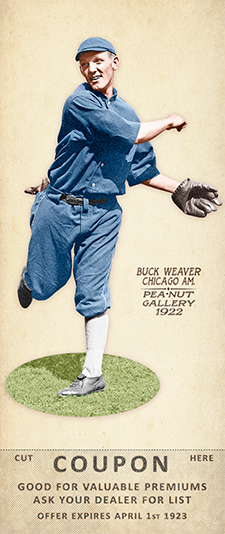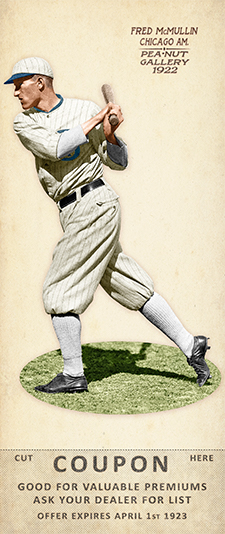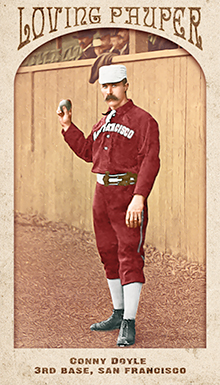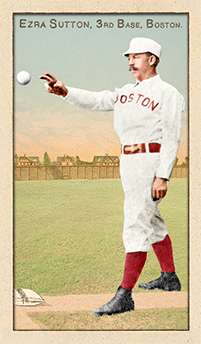
- Series: 1919 Black Sox Scandal
- City: Chicago
- Team: White Sox
- League: American League
George Daniel Weaver (1890-1956) climbed to a lofty height during his baseball career and plummeted to an historic low that would test any man. Buck’s dad insisted he forego his mother’s funeral to begin his pro career in the White Sox system. He ended his career when Judge Landis banished him from the game along with 7 fellow Sox. In between, this gregarious, cheerful soul basked in the shadows of the Great Pyramid sporting a fez during the 1913 world tour and danced for joy after Comiskey’s club locked up the ’17 Series, a team he had led in batting and afield. Although pilloried with his teammates for throwing the 1919 Series, Weaver played errorless ball, hit .324, and was never accused of taking money. He would spend the rest of his life trying to clear his name. After Cicotte and Jackson confessed, the Sporting News headlined: “Chicago Fans Grieve Most for Weaver and Still Hope for Him.”
- Played exclusively for the White Sox (1912-1920), averaging .272, and was the only banned player to remain in Chicago
- Buck successfully sued his penurious owner for his 1921 salary

- Series: 1919 Black Sox Scandal
- City: Chicago
- Team: White Sox
- League: American League
Fred Drury McMullin (1891-1952) has been called the “forgotten man” of the Black Sox. Writing for SABR, Jacob Pomrenke called McMullin the "Eighth Man Out, the most obscure of the White Sox players who agreed to throw the 1919 World Series to the Cincinnati Reds."
As a nondescript utility man with little promise to impact the series, Fred would certainly seem to be the unlikeliest member of that talented team to be pursued and paid off by gamblers. Some have suggested that, as the team’s scout, Fred may have contributed to the scheme by providing misleading information to his teammates about Reds hitters and pitchers. Or perhaps, as it is most commonly suggested, McMullin implicated himself in the scandal when he allegedly overheard talk of throwing the Series and insisted on his inclusion in the conspiracy. And yet Ed Cicotte testified that "the idea of the fix had originated in a conversation with Gandil and McMullin." Like so many mysteries that will forever envelope the 1919 Black Sox, the truth of how and why Fred McMullin was involved in the scandal may never be known.
McMullin had come out of West Coast ball where he impressed the Tigers enough to give him an audition at the end of the 1914 season. Fred languished on the bench, watching the likes of Cobb and Crawford before getting his only appearance that year in Fenway, mopping up a Red Sox laugher and striking out in his only at-bat. Returning to California allowed Fred to build his resume and the White Sox signed him for the ‘16 campaign. Again, he joined a stacked team with little chance of breaking into the lineup. In 1917, McMullin got into late-season games and did well; especially helping with his defense in the Series against the Giants, which the Sox won. Fred used his $3,600 bonus to buy a small house.
Following the war-shortened ‘18 season, the White Sox were again a dominant force in 1919. Owners feared the year would be a loss in the war’s aftermath and scheduled another truncated schedule which included smaller player paychecks. In the lead-up to the postseason, Chick Gandil seems to have led the conspiracy that would ensnare Fred and six more teammates.
- McMullin stayed mum the rest of his life concerning the fix
- Unlike his teammates, Fred didn’t try to barnstorm, but he did play some semi-pro ball in LA - until Irish Meusel was fined $100 by the Phillies for playing against him
- McMullin ended his working life in law enforcement, as a court marshal in Los Angeles, and died on the job from a stroke
- Series: Athletic of Philadelphia: 1874
- City: Philadelphia
- Team: Athletics (NAPBBP)
- League: National Association (NAPBBP)
This cabinet is currently on the drawing board and is coming soon.
Ezra Ballou Sutton (1849-1907). A 3rd baseman & shortstop, Sutton played for 5 teams over 20 seasons. Ezra was the 1st player to hit a home run in Major League baseball and became the 1st player to hit 2 HRs in one game when he hit his second that day (in a losing effort). Sutton was also one of the 1st ball players to collect 1,000 career hits.
- Played in 1st National Association game: 5.4.71
- Played in 1st National League game: 4.22.76
- Lifetime .294 batting average
- Sutton is tied with 17 other players as the first player in major league baseball history
- Series: Beginnings: 1880's
- City: Boston
- Team: Beaneaters
- League: National League
Ezra Ballou Sutton (1849-1907). A 3rd baseman & shortstop, Sutton played for 5 teams over 20 seasons. Ezra was the 1st player to hit a home run in Major League baseball and became the 1st player to hit 2 HRs in one game when he hit his second that day (in a losing effort). Sutton was also one of the 1st ball players to collect 1,000 career hits.
- Played in 1st National Association game: 5.4.71
- Played in 1st National League game: 4.22.76
- Lifetime .294 batting average
- Sutton is tied with 17 other players as the first player in major league baseball history

- Series: 1880s: Loving Paupers
- City: San Francisco
- Team: Haverlys
- League: California League
Cornelius J. Doyle (1862-1931) was an Irish immigrant who played outfield for two seasons in the major leagues. He was with the early forerunner to today’s Phillies, the Quakers, in 1883. He had one more attempt at staying at the top of his profession with the Pittsburgh Alleghenys of the American Association in 1884. The AA lasted for a decade following its founding in ‘82. The Alleghenys would eventually morph into today’s Pirates. Conny’s tenure was brief and his stints with both clubs equally so. He saw action in 16 games for the Quakers and 15 for Pittsburgh. He sported an anemic .221 average in his rookie campaign, but finished with a flourish as he hit .293 with the Alleghenys.
Doyle had begun at the pinnacle of baseball, the National League, in ‘83 as a twenty-one year old. His poor batting sent him down to the Northwestern League’s Quincy (IL) Quincys in 1884 where his fine .304 average earned him the next shot with Pittsburgh later that year. He led the Quincys with four home runs playing aside ten other future major leaguers, including Ice Box Chamberlain and Kid Baldwin. Doyle knocked around the minors for the next decade, playing regularly for the likes of the Lynn (MA) Shoemakers, Atlanta Atlantans, Peoria Canaries and the New Haven Nutmegs. In 1889 Conny was captured by photographers in his San Francisco Haverlys uniform during a brief west coast assignment. He closed his pro career with two widely-dispersed teams in 1893: the Dover club of the New England League and the New Orleans Pelicans of the Southern Association. This young immigrant found baseball an ideal vehicle to tour his adopted land.
- At age 31 Doyle was far from the grizzled veteran of the Pelican squad. Dick Phelan was 38 and two other teammates were senior to Conny
- One of those teammates was Kid Baldwin, indicating the twists and turns of pro ball in the 19th century. The Kid and Conny were rookies in Illinois and followed very different routes in their respective careers, but both found themselves closing out their baseball lives with the same New Orleans franchise in 1893
Auction History
Cartophilia
Old Judge Pose: 133-1




